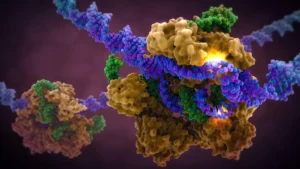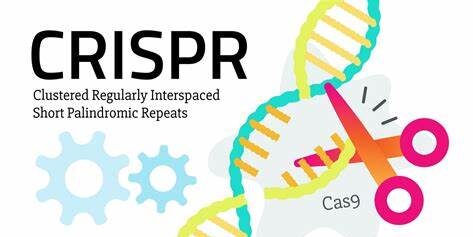Read time 6 minutes
This blog is another opportunity to feel grateful. Thank you, dear Universe, you continue to bless me with recovery and health.
The purpose of this blog is to share if Gene editing technology like CRISPR could cure my rare symptoms.
Q) Can Gene editing rewrite our DNA? Let’s find out…
In simple words, DNA (deoxyribonucleic acid) is the blueprint of who we are. It handles how our bodies function. It contains all the information needed to build and maintain an organism. In short, it’s not wrong to say that DNA is like a genetic instruction manual for living organisms.

The evolution of humankind has achieved unbelievable capabilities including genetic changes. Many of these genetic changes can be used in the fight against rare and chronic diseases. These modifications can treat or cure cancers, inherited disorders, and even rare diseases.
In 2016 I was diagnosed with a rare disease called Isaacs’ Syndrome. Isaacs’ is a neuromuscular health condition that stems from muscle hyperactivity. In the process, I also discovered that I had Lyme disease. Lyme is a bacterial illness that gets transmitted through ticks. I was also accompanied by Glaucoma. Glaucoma is an eye-related disease that damages the optic nerves. And Membranous Glomerulonephritis is a progressive kidney disease.
There are about 6000 to 8000 rare hereditary disorders. An estimate says that approx. 250 new conditions are waiting to be named every year. In such a case, it becomes important to diagnose and treat these conditions at their early stages. This could help enhance and improve the quality of human life.
The Concept of Gene Editing
Q) What is Gene Editing?
It is a revolution in itself. A technology that can make necessary changes in the DNA sequence. Even inserting or removing a gene is possible, altogether. The idea is to identify and correct genetic mistakes causing diseases. Researchers claim that necessary changes in the DNA could impact health positively.
Researchers are working on gene editing to treat various health conditions, even inherited and rare. There are various techniques used in gene editing, such as CRISPR, Zinc finger nucleases, and TALENs. These techniques have immense potential not only to treat symptoms but also to cure the disease by addressing the root cause.
There have been some interesting developments in this field:
- Prime Editing (PE)
It is capable to search and replace specific genetic sequences. It helps in expanding the range of possible edits by insertions, deletions, etc. It has been successfully applied in the model of animals and plants.
- Base Editing (BE)
It is capable of changing an individual’s DNA base. Without disruption of the DNA strand, this process can convert the base pair to another.
- RNA Editing
It is capable of making discrete changes to specific nucleotide sequences. It modifies RNA molecules post-transcription. It allows cells to create diverse proteins from a single gene.
Unveiling the CRISPR Technology
CRISPR is short for Clustered Regularly Interspaced Short Palindromic Repeats. It is a cutting-edge technology that allows a change in the DNA of living organisms.
CRISPR was originally discovered in bacteria. It served as a natural defense mechanism, to recognize and combat specific viruses.
There are two basic components to CRISPR:
- CRISPR-associated (Cas) nuclease:
This nuclease is an enzyme that handles performing the actual DNA editing.
- Guide RNA (gRNA):
It recognizes the target DNA region of interest.
CRISPR’s working process involves Recognition, Guidance, Cleavage, and Repair.
To conclude, CRISPR’s strength lies in its ability to edit DNA. It uses RNA and opens up new possibilities for science. It is a great tool for the future to fight against many uncommon and rare diseases.
Key Uses of this Technology
- It has been used to engineer probiotics. It has also proven effective in immunizing industrial cultures against infections.
- Researchers are working and exploring CRISPR-based therapies to treat genetic disorders.
- Scientists use it to study gene function, regulatory elements, and disease mechanisms.
- This system has been employed to change genes in plants, animals, and bacteria. Scientists gain tremendous insights into the effects of genetic modifications.
- CRISPR contributes to various agricultural advancements. It magnifies the growth of crops. It improves their nutritional value and increases drought tolerance.
CRISPR is a versatile technology. It is a turning point in medicine, agriculture, evidence-based studies, and scientific research. And has the potential to go way beyond.
Can CRISPR Help with Rare Symptoms and Chronic Diseases?
CRISPR holds immense promise in treating various rare symptoms and chronic diseases. It is capable of treating various neurological and other disorders.
However, no specific study has yet been conducted to prove CRISPR’s potential to cure Isaacs’ Syndrome. However, researchers are exploring the possibility of treating many neurological diseases through CRISPR.
Clinical applications are still in the early stages and the advancements are promising. However, continued research and testing are essential to ensure safety and efficiency.
Diseases that could potentially benefit from CRISPR gene editing therapy:
CRISPR has opened doors to treating diseases like Parkinson’s, Alzheimer’s, and Dementia. Also, other neuro conditions like Huntington’s, Duchenne Muscular Dystrophy, and Dravet Syndrome.
It can potentially correct genetic mutations associated with many of these conditions. It can restore brain health, and slow down neuron degeneration and disease progression. Also, increases dopamine production, changes proteins, and enhances the clearance of toxins.
Having said that, scientific progressions are time-consuming breakthroughs. But they offer future hope for better disease management opportunities.
Some success stories in using CRISPR to address rare symptoms and chronic diseases:
- CRISPR’s success in addressing a Rare Disease:
In 2019, a woman with sickle cell disease made a comeback using CRISPR technology. Scientists also treated a rare genetic condition causing blindness.
-
Researchers are targeting Cancer with CRISPR:
Clinical trials are going on to treat cancer with the help of CRISPR. One such trial targets the CD70 protein. This protein is present on the surface of cancerous cells.
-
Gene Swaps to Prevent Vision Loss:
The University of Pennsylvania developed a gene therapy for severe vision loss. It has shown promising results in patients with Leber congenital amaurosis (LCA). LCA is an eye condition that causes total blindness.
To Summarize:
CRISPR technology has generated immense hope for patients battling rare diseases. We are slowly getting closer to transformative treatments.
Challenges and Ethical Considerations
CRISPR therapy is a revolution and holds immense promise for treating genetic disorders. However, even this powerful tool comes with its own set of limitations and challenges.
- It’s possible that sometimes it accidentally edits genes other than the target.
- Effective delivery of CRISPR components into target cells remains a hurdle.
- The immune system may react to CRISPR taking it as a foreign component.
- Unintended immune reactions could delay and reduce the effectiveness of the therapy.
- It is challenging to achieve complete and precise efficiency in all target cells. This could hinder the success rate of the therapy.
- The long-term effects of CRISPR therapy and the edits are not fully understood.
- There are concerns that gene editing could also have potential misuse for enhancements.
- The ethical aspects surrounding gene editing are many. It involves adhering to human rights, safety, and reaching goals. Proper governance and dialogues are needed to sail through this technology.
To Conclude
Rare diseases, affect patients around the globe and pose significant challenges. Many of these health conditions often remain misdiagnosed due to inadequate expertise.
CRISPR-Cas9 is proving to become a revolutionary gene-editing system. It allows precise changes to the DNA. Scientists can either disrupt or correct specific genes trying to address many diseases. Rare and Chronic ailments that had no answers yet are hopefully to be addressed.
While CRISPR holds immense potential, however, challenges remain. Minimizing off-target effects, and ensuring patient safety are important before advancing clinical practice.
I encourage my readers to stay informed and educate themselves on the latest advancements in gene editing. It has tremendous potential to impact health and well-being.
Let’s try our best and continue to raise necessary awareness.
DISCLAIMER
The views expressed above in this article are the author’s own and do not represent any kind of medical advice.
Reference
CRISPR-Cas9-Mediated Gene Therapy in Neurological Disorders | Molecular Neurobiology (springer.com)
CRISPR for neurodegenerative diseases: could it be a cure? (labiotech.eu)
Four Success Stories in Gene Therapy (nature.com)


